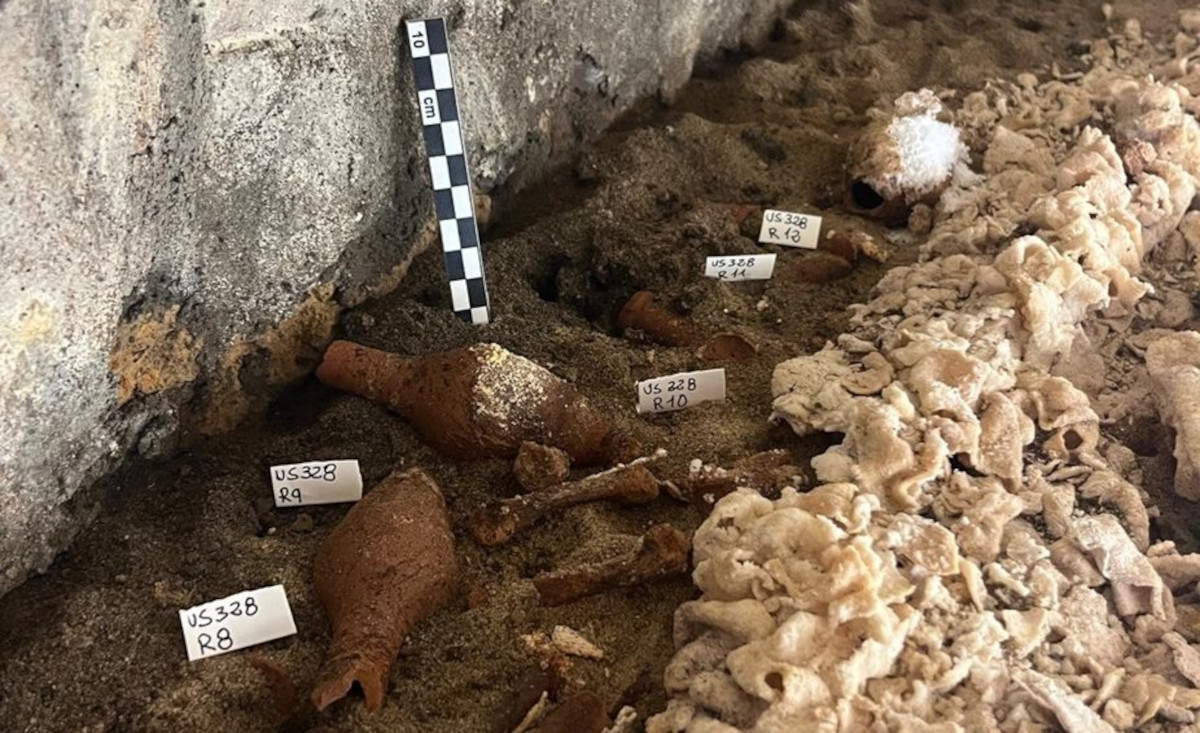Investigations in the Tomb of Cerberus in Giugliano are continuing, ahead of the resumption of excavations in the surrounding necropolis and restoration work on the frescoes funded by the Ministry of Culture. Thanks to a targeted intervention and the use of a microcamera, a gap has been opened in the sarcophagus, which has remained sealed for more than 2,000 years, allowing access to its interior. The excavation operations, coordinated by archaeologist Simona Formola, led to the exceptional discovery of a burial in an excellent state of preservation. A supine inhumed body was found, covered by a shroud that was probably mineralized due to the special climatic conditions of the burial chamber. Several grave goods, including unguentaries and strigils, were found around the body. The care with which the inhumate was buried and the dating of the objects suggest that he may have been the progenitor of the family for whom the mausoleum was built.
“The Tomb of the Cerberus continues to provide valuable information about the Phlegraean territory near Liternum,” said Superintendent Mariano Nuzzo, “broadening our knowledge of the past, and offering opportunities for research that is also multidisciplinary in nature.” “In recent months, in fact,” the Superintendent continued, “laboratory analyses conducted on samples taken from inhumates and burial beds have returned a considerable amount of data about the treatment of the bodies of the deceased and the funerary rituals enacted, greatly enriching the panorama of our knowledge. It was a team effort led by the Superintendency, involving archaeologists, technicians, anthropologists, paleobotanists, and chemists, united in the common goal of interpreting the data collected and unraveling the site over time.”
Complex procedures were adopted to carry out various analyses. Professor Margarita Gleba from the laboratory of the University of Padua examined the textiles to determine the structure of the yarn, the type and quality of the textiles in order to derive cultural and sociological information. Professor Maria Rosaria Barone Lumaga, a researcher at the Department of Plant Biology, University of Naples Federico II - Real Orto Botanico di Napoli, conducted microscopic observations of organic substances in some containers. Pollen analyses carried out by archaeobotanist Monica Stanca, in collaboration with Dr. Marco Marchesini and Dr. Silvia Marvelli of the CAA (Centro Agricoltura Ambiente “Giorgio Nicoli”), suggest that the bodies of the inhumates may have been treated with chenopodium and wormwood creams for better preservation. DNA analysis of the individuals is still ongoing, thanks to the work of bio-anthropologist Barbara Albanese in collaboration with Dr. Pontus Skoglund, Dr. Thomas Booth and Dr. Sarah Johnston of the Skoglund Ancient Genomics Laboratory at the Francis Crick Institute.
Continued archaeological research and laboratory sampling and analysis in the coming months will yield additional interesting data not only from the hypogeum, but also from the surrounding necropolis. These data will be useful in reconstructing the historical and social context of an ancient community that still has much to reveal.
 |
| Cerberus Tomb investigation continues in Giugliano: burial and grave goods discovered |
Warning: the translation into English of the original Italian article was created using automatic tools. We undertake to review all articles, but we do not guarantee the total absence of inaccuracies in the translation due to the program. You can find the original by clicking on the ITA button. If you find any mistake,please contact us.